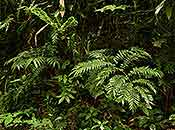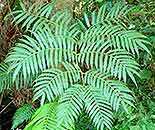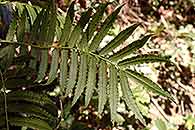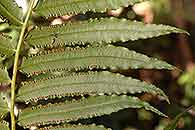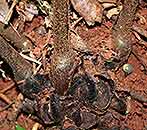Ptisana salicifolia (Schrad.) Senterre & Rouhan
Synonyms |
Marattia salicifolia Schrad. |
|---|---|
Common name |
|
Description |
Rhizome massive, forming an upright caudex, up to 40 cm high and 30 cm across. Fronds tufted, arching, (1–)2.5–4 m tall, stiffly fleshy. Stipe up to 1.5 m long, fleshy, light green or often purplish brown and with 4 cm long whitish or green streaks, base swollen and flanked by a pair of thick green to purplish fleshy basal stipules, sparsely and minutely tuberculate or prickly towards the base which is thinly clothed in narrow rust coloured scales. Lamina 1-3 × 0.5-1.5 m, bipinnate, ovate in outline. Pinnae in 6–9 pairs, up to 80 cm long, imparipinnate, oblong to oblong-lanceolate in outline, rarely divided at the apex, with a fleshy swelling at the base; pinna-rachis often winged. Pinnules up to 16 x 2.5 cm, narrowly oblong-lanceolate in outline, margin sharply toothed, apex tapering to a point, base unequally wedge-shaped, venation prominent below, glabrous save for sparse minute scales along the costule. Synangia very distinctive, capsular with linear opening, situated singly towards the end of each vein, c. 2-2.5 × 1 mm, grey-green drying brown. |
Notes | |
Derivation | salicifolia: with leaves like a Salix (a willow). |
Habitat | Along streams in deeply shaded evergreen forest , montane forest, swampy places. |
Distribution worldwide | Africa, Mascarene islands, Madagascar. |
Distribution in Africa |
Angola, Burundi, Cameroon, Central African Republic, Congo, Dem. Republic of Congo, Equatorial Guinea (incl. Bioko), Ethiopia, Gabon, Ghana, Guinea, Ivory Coast, Kenya, Liberia, Malawi, Mozambique, Nigeria, Rwanda, Sierra Leone, Sudan and South Sudan, Swaziland, Tanzania , Zimbabwe. |
Growth form |
Terrestrial. |
Literature |
|

